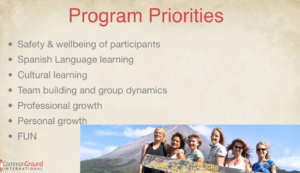CGI’s General Approach to Ensure Safety and Manage Risk on Spanish immersion:
Common Ground International employs a 4 component comprehensive, pre-emptive, proactive risk management approach that begins with:
- An extensive preparation and training for all Common Ground representatives and participants before they even hit the ground in their immersion program
- Continues in country with specific systems, protocols and back-up plans
- Concludes with post program evaluation, board meetings and reviews
We prefer to over prepare our participants and over-train our program leaders than risk being underprepared. Our risk management approach includes the 4 major components below to ensure high quality, safe and excellent international experiences for all of our staff and participants. Learn more about the steps we take!
Our Approach to Risk Management is Safety, Security and Solutions Orientated through these 4 components:
- Pre-departure planning, preparation & prevention
- Leader experience and training
- Well vetted, professional, expert partners & contractors
- Health, safety and emergency response plans
1. The 3 P’s: Pre-departure planning, Preparation & Prevention:
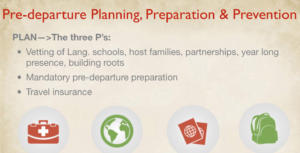
Since 2003, we have successfully and safely run Spanish Immersion Programs in Central America. Sustainability and deep roots are our friends. We have long lasting relationships with local community members, language institutes, non-profit organizations, NGO’s in both the private and public sectors, local host families, transportation companies, hotels, tours, guides and many other local contractors.
Since the early 2000’s, we have developed program activities, logistics, accommodations, itineraries, and transportation with these long standing associates to mitigate as much risk as possible. We continue to manage risk by requiring all participants to:
- Complete a 13 lesson online prep-departure course: Participants will demonstrate knowledge of program expectations specifically relating to:
- Passport requirements
- Center for Disease Control Recommendations
- Host Family Expectations
- Language School Expectations
- 5 Stages of Cultural Adjustment
- Country Specific Information
- Educational Volunteer Projects
- Emergency Procedures
- Health and Safety Policies
- On-site orientation
- Cultural norms and expectations – including perceptions of North Americans
- Behavior expectations: 1 and 2 strike policies
- Participants are required to complete required readings and assignments before their program begins
- Participants are required to attend 3 orientation / preparation meetings before their program start date
- All participants must complete:
- Health History forms, medications, allergies
- Indicate emergency contacts
- Sign behavior contract
- Sign liability contract
- Sign media release contract
- Register in STEP program
- Read and be familiar with country specific CDC health recommendations
- All participants much submit their individual Emergency Action Plan (link up). Creating a thorough Emergency Action Plan (EAP) for travel abroad is a standard practice in the field of international education. It combines all critical contact information in one document, as well as enumerating the concrete steps to take in case of an emergency.
CGI purchases a travel insurance policy (through CIEE, iNext plan) for each participant that includes such things as:
- Trip cancellation for death or sickness of individual
- Trip delay
- Travel medical coverage
- Medical evacuation
- Loss of baggage
- Download and read program manual and / or parent manual where safety protocols, communication pathways, emergency response and much more is detailed
- Download and save on hand Immersion Emergency Numbers documents
2. Leadership Experience and Training:
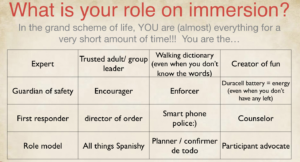
An immersion trip leader takes on many roles while leading a program. It is essential that we pin point the exact leaders for our CGI team. In addition to the specified core capabilities, background experience and gusto. Our trip leaders must demonstrate these 3 core capabilities in various areas of their lives from professional to personal!
- HUNGER
- HUMILITY
- SMARTS
After our trip leaders have been carefully vetted and hired, we require all trip leaders to go through a process of learning how to be an immersion leader to actually leading in pre, during, and post immersion activities.
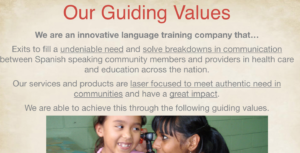
In the training stages, immersion leaders will:
- Understand what it means to be part of the CGI team
- Commit to upholding to vision, mission and program objectives
- Comprehend in detail what it entails to lead our immersion programs
- Become an active, engaged, committed member of CGI Immersion Leadership Team
After leaders complete the training they will:
Enthusiastically and positively LEAD program participants to the best of your abilities while upholding program objectives such as:

- smooth and effective programing
- ensuring safety and minimizing risk
- keeping all things Spanish(y)
- Guiding personal / professional growth opportunities, program debriefs and reflections
Leadership training includes:
- First aid and CPR certification
- A 4 module, 24 lesson leadership training course and assignments with each lesson. Topics include:
- CGI Core Training: Guiding Values, Mission, Vision, Ob
jectives, Systems and Protocals
- Leadership Roles & Responsibilities: pre, during & post trip, working with host families, language schools, group coordination, transportation, excursions, outreach partnerships
- In’s and Out’s of Daily Leadership: Topics include: Behavior expectations, smart phone policy, communication pathways, group meetings, program orientation, immersion reflection, dress code, etc.
- Risk management, safety, Health and Emergency Protocols: Topics include: Approach to ensure safety, Leader Experience & training, Framework for evaluating situations, health and emergency response protocols, Lost & stolen items, etc.
- CGI Core Training: Guiding Values, Mission, Vision, Ob
- Bi-weekly and weekly meetings with program director (beginning 8 months before program begins) to discuss leadership training, program logistics, program participants, in-country health, safety, and emergency protocols and more!
- Program Paperwork: review mission statement, contracts, etc.
- Participants: Familiarize yourself with participants on paper and get to know them in the 3 program meetings
- Itinerary: Get uber familiar with leader itinerary
- Volunteer Projects: Guide, support and assist in participant planning
- Google Hangouts: Co-Create, Schedule, Lead, Follow-up
- Set tone: of group & establish program objectives
3. Vetted, Professional Partners & Contractors – bar of excellence!
Since the early 2000’s, we have developed program activities, logistics, accommodations, itineraries, and transportation with these long standing associates to mitigate as much risk as possible. We follow these steps to ensure excellence in partnerships, contractors and all program elements:
- Pre-Program Actions: Before an Immersion Program is established, program directors personally…
- Visit country and in-country sites to determine feasibility while also taking into account:
- Country specific information and safety of location
- City / town specific information and safety of location
- Reviewing travel warnings and advisories over a set period of time and continuing to stay up to date with travel warnings and advisories such as:
- Meet with potential partnerships and use a framework for vetting to ensure excellence
- Observe teachers at language institutes and check experience and training of teachers
- Visit host families
- Run pilot programs before immersion programs are established
- Review ratings, references and reviews before partnering with contractors
- Run background checks when possible on host families
- Lead teacher trainings
- Lead host family oreintations
- Review and incorporate best practice and respond to changing risk scenarios:
- Visit country and in-country sites to determine feasibility while also taking into account:
- During programs, actions that we take are:
- Immersion directors personally visit immersion program home-bases at least once each year to touch base with all partners and contractors
- Maintain daily communication with program directors, trip leaders and local partnerships
- For any health, safety or emergency incident there is a incident report to be filled out and trip leaders take note on program record
- Post Program Actions:
- End of program debrief meetings and reviews with on-site staff, partnerships and contractors
- End of program evaluations
- Committee review of program record and note taking, decide upon next steps if needed
4. Health, Safety & Emergency Response Plans:
Plan and Prepare for the “What Ifs”
At Common Ground, we have a 3 step approach to manage risk: PLAN, EVALUATE & RESPOND
These topics are a huge deal and often times the deal breaker on whether participants will jump into this opportunity or not. By far, the most frequently asked questions we get about our program are:
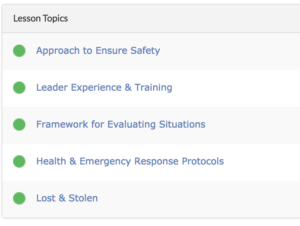
- What if I get sick?
- What do you do if there is an emergency?
- How safe is the town that you are going to?
- How do you vet the host families?
In our online Health, Safety & Emergency Response Training, leaders and participants will learn how we manage risk, the tools and framework to evaluate situations and various safety protocols. The lessons in this lesson include:
- Our Approach to Ensure Safety
- Leader Experience & Training to Ensure Safety
- Framework for Evaluating Situations
- Sickness and Emergency Protcols
- Lost & Stolen | What to do
In addition to this online training, all participants must:
- Download and read Health & Safety Guidelines and Policies
- Submit their Emergency Action Plan (EAP): Creating a thorough EAP for travel aboard is a necessity. It combines all critical contact information in one document, as well as enumerating the concrete steps to take in case of an emergency.
Maintain on hand the travel insurance policy for each participant that includes such things as
- Trip cancellation for death or sickness of individual
- Trip delay
- Travel medical coverage
- Medical evacuation
- Loss of baggage
- Download and read program manual and / or parent manual where safety protocols, communication pathways, emergency response and much more is detailed
Thank you for taking the time to learn about how we ensure the best programming possible for our immersion experiences.
Since the early 2000’s we have continued to improve, modify, evaluate and implement changes to all program components. In today’s changing society, it is imperative to stay on top of the game and make adjustments as needed. This plan is an evolving plan to in order to accommodate the rapidly changing global landscape. Be sure to check back for updates and changes frequently.

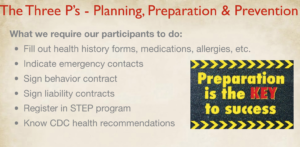
 jectives, Systems and Protocals
jectives, Systems and Protocals